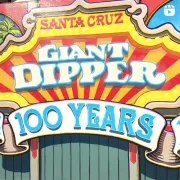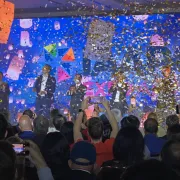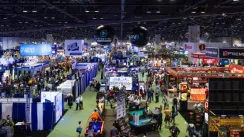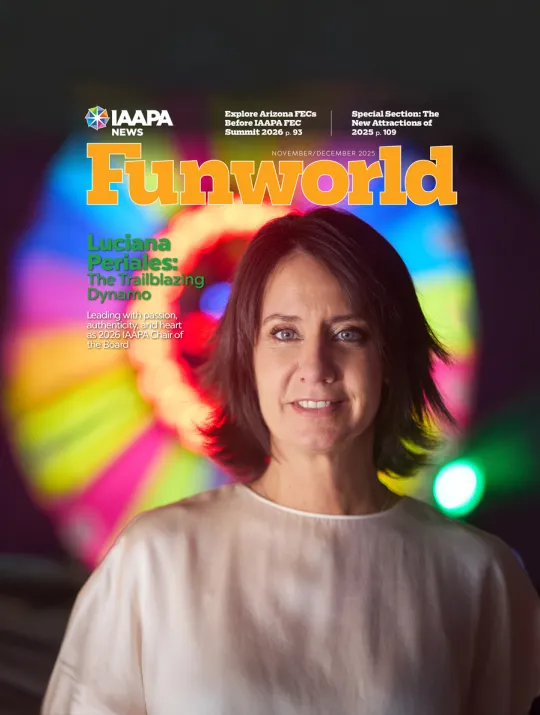- Attendees
Tour button
IAAPA Expo On-Site Information
Find important information below as we prepare for IAAPA Expo, taking place November 16 - 20, 2026 in Orlando, Florida. We look forward to seeing you there!

Grid A
Registration and Ticket Information
Expand allHelp With Registration:
Attendee and Exhibitor IAAPA Expo Registration:
• Email: [email protected]
Press, Media, and Influencer IAAPA Expo Registration:
• Email: [email protected]
Help with Membership:
IAAPA North America
• Email: [email protected]
• Phone: +1 321-319-7688
IAAPA Asia Pacific
• Email: [email protected]
• Hong Kong Phone: +852 2538 8799
• Shanghai Phone: +86 21 8033 7435
IAAPA Europe, Middle East, Africa
• Email: [email protected]
• Phone: +32 492 72 02 68
IAAPA Latin America and Caribbean
• Email: [email protected]
• Phone: +52 55 4368 7381
South Concourse
Saturday, Nov. 14 11 a.m. – 5 p.m.
Sunday, Nov. 15 8 a.m. – 5 p.m.
Monday, Nov. 16 7:30 a.m. – 7 p.m.
Tuesday, Nov. 17 7:30 a.m. – 6 p.m.
Wednesday, Nov. 18 8 a.m. – 6 p.m.
Thursday, Nov. 19 8 a.m. – 6 p.m.
Friday, Nov. 20 9 a.m. – 4 p.m.
West Concourse
Saturday, Nov. 14 11 a.m. – 5 p.m.
Sunday, Nov. 15 8 a.m. – 5 p.m.
Monday, Nov. 16 7:30 a.m. – 7 p.m.
Tuesday, Nov. 17 7:30 a.m. – 6 p.m.
Wednesday, Nov. 18 8 a.m. – 6 p.m.
Thursday, Nov. 19 8 a.m. – 6 p.m.
Friday, Nov. 20 9 a.m. – 4 p.m.
Registration for children 17 years of age and younger is complimentary, but children must wear an identification wristband at all times (available for free at on-site Registration with a registered adult). Anyone age 18 years or older is required to pay the registration fee to access the trade show floor. See Children Policies for IAAPA Expo
EDUTours and events that are not sold out can be purchased at Registration in the OCCC, West or South Concourses. All breakfasts, lunches, and receptions are ticketed events with a separate registration fee. Space is limited and may sell out. There are no printed tickets. Tickets are tied to the badge which will be scanned for access to the event. No one under the age of 18 may participate in EDUTours or special events including IAAPA Celebrates.
An IAAPA Expo name badge is required for admission to all Expo activities, events, and services, including the trade show, shuttle buses, and Opening Ceremony. It also provides IAAPA members with free admission to the Education Conference. Non-members must pay a separate fee to access the Education Conference program. Name badges must be worn at all times while in the OCCC and while participating in any Expo events. No buyer or attendee can be admitted with an exhibitor badge, nor should an attendee or exhibitor try to gain entry to the trade show with a badge that indicates a name other than their own. Exhibitors must also wear their badges at all times. Badges can be revoked at IAAPA’s discretion. Any lost or misplaced badges must be repurchased for $100. If lost badges are later found, the purchaser may submit the found badge and a letter requesting a refund to IAAPA. IAAPA will evaluate each refund request on a case-by-case basis.
Tickets for special events are available for pre-purchase online as well as on-site based on availability. Each registrant may only purchase one ticket per event. Tickets are tied to the badge and not printed. Tickets are non-refundable. Contact Registration to switch a ticket to another registrant. You must be registered for the Expo and at least 18 to attend any ticketed function.
Regardless of rain, all outdoor special ticketed events and EDUTours will continue as scheduled.
Only written requests to [email protected], received on or before 30 days prior to the start of the Expo will receive a refund, less a 10% processing fee. Special event tickets, charity items, and upgrades are non-refundable under any circumstances. Cancellations due to illness or emergency will be evaluated by the IAAPA team on a case-by-case basis.
All attendees will be required to provide a picture ID to collect their badge or purchased tickets on-site. Students and Faculty will be required to provide a current student or faculty ID from a degree-granting university or college.
Students attending IAAPA Expo should be familiar with the guidelines, and resources available to them for a quality experience. Review this information here.
IAAPA will provide visa letters or letters of invitation for attendees and exhibitors during the registration process. Your visa letter will be sent to you by email upon completion of registration. Please contact [email protected] for any additional help needed.
Grid A
On-Site General Information
Expand allPlease contact IAAPA at [email protected] or stop by our Show Office in Room S221 in the South Concourse. You can also call our Show Office at 407-685-6103 during the week of Nov. 16-20 (please note that this number will not be active outside of the week of Nov. 16-20).
Accessibility/Mobility Equipment
- Mobility equipment is available to rent from Scootaround in room S210A. Click here for more information about renting a scooter, wheelchair, or stroller or to make a reservation in advance for a scooter or wheelchair. Strollers can only be rented on-site. For questions on accessibility, please contact [email protected]
Translation Services
- IAAPA will not have any individual translation services available during IAAPA Expo. Exhibitors or attendees may arrange translation in advance through the official contractor, Image Talent Agency. Some education sessions will have translation in Spanish or Portuguese. Look for the Translation Icon next to available sessions.
Business Center
- The OCCC FedEx Office is open daily from 8 a.m. to 5 p.m. to assist attendees with a variety of services including printing, shipping and receiving packages, ship to home services and more.
Charging Stations
- Chargerent is sponsoring charging stations for attendee use at no charge during IAAPA Expo. Charging stations will be located in both the West and South Concourses and inside the Member Lounge (S222).
Wellness Room for Nursing Mothers
- The OCCC has Wellness Rooms available for use by exhibitors and attendees who are nursing mothers and seek a private setting for the purposes of breast feeding, pumping, or who require rest for medical reasons. Nursing mothers who are pumping may utilize the refrigerator in the room to store milk. There is a room available on Level 2, West Concourse, in the West C Lobby and Level 2, South Concourse, adjacent to room S210E. The room is NOT intended to provide space to rest for those with medical conditions that are highly contagious from contact with contaminated surfaces, e.g. influenza, stomach viruses, common cold, pink eye, etc. Individuals with those types of medical conditions should seek medical care as appropriate. Please respect the privacy of individuals who make use of this space. There is also a remote Nursing Mothers Room on the show floor in the Exhibitor Services Area, south side of the center of the pod.
Wi-Fi
- Complimentary Wi-Fi will be available in all public spaces of the North and South Concourse (lobbies) at the OCCC, in education session rooms, and on the trade show floor. Wi-Fi on the trade show floor is broadcast in 5Ghz only and is intended for standard email and web browsing. Please do not upload/download large files, stream videos, or use anything that requires substantial bandwidth, or the Wi-Fi will not work for you or anyone else. Wireless network name is "_IAAPA WiFi by LightUpToys.com".
Bag and Coat Check
- Bags and coats may be held at the Bag and Coat Check located in Room S210B on Level 2 in the South Concourse for a fee of $4 per item. The Coat and Bag check will be in operation on Nov. 17-19 from 8 a.m. – 6:30 p.m. and Nov. 20 from 8:30 a.m. – 4:30 p.m.
Interfaith Prayer & Meditation Room
- An interfaith prayer and mediation room is available in Room N312 on Level 3 in the North Concourse. Please be respectful to others using the space.
Sensory Room
- A sensory room is available in Room N311 on Level 3 in the North Concourse for those that need a break from the stimulation of the Expo. Please be respectful to others using the space and leave all items provided inside the room.
If you have any questions or feedback about the services provided during IAAPA Expo, please contact [email protected].
Feel free to use the various lounge and seating areas available during IAAPA Expo!
- IAAPA Member Lounge sponsored by Storibox - Destination Lounge (S222) near the South Hall B Entrance, South Concourse on Level 2. IAAPA members are welcome to use this comfortable seating area to work, relax, or catch-up with colleagues. The Member Lounge is exclusive for IAAPA members and coffee service is available. The lounge will be open:
Nov. 16-19, 8:30 a.m. - 5:30 p.m.
Nov. 20, 9 a.m. - 4 p.m.
- IAAPA Attendee Lounge, Sonic's Green Chill Zone, sponsored by SEGA - Location TBD. When your feet are exhausted after navigating 9 miles of aisles at super-sonic speed on the trade show floor or you need a mental break from the day's education, stop by the attendee lounge for a relaxing breather before heading back to the show floor or to your next EDUSession. The lounge will be open to all attendees:
Nov. 17, 9 a.m. - 5:30 p.m.
Nov. 18, 11:45 a.m. – 5:30 p.m.
Nov. 19, 9 a.m. - 5:30 p.m.
Nov. 20, 9 a.m. - 3 p.m.
- VIP Lounge, sponsored by TAIT - Exclusive for Hosted Buyers and VIP Experience attendees, located in Room S220FG in the South Concourse, Level 2. The lounge will be open:
Nov. 16, 9 a.m. - 5 p.m.
Nov. 17-19, 8:30 a.m. - 6 p.m.
Nov. 20, 9 a.m. - 4 p.m.
Tuesday, Nov. 17 10 a.m. – 6 p.m.
Wednesday, Nov. 18 10 a.m. – 6 p.m.
Thursday, Nov. 19 10 a.m. – 6 p.m.
Friday, Nov. 20 10 a.m. – 4 p.m.
More than 25 different dining options are available at IAAPA Expo, including restaurants and concession stands. There’s something for everyone, with healthy choices and vegan, vegetarian, and gluten-free selections available in many locations. Food trucks located outside by the South Outdoor Exhibit area and available Nov. 18-21 from 11 a.m. - 3 p.m. daily. A concession area with seating is available at the back of South Hall A beyond the Show Production & Design Pavilion.
More information COMING SOON
Shuttle Buses
- Shuttle bus signage and schedules for transportation to the OCCC are available in each of the shuttle route hotels below. All buses will drop off and pick up on the South and West Concourses of the convention center.
- IAAPA Expo 2026 Shuttle Information Schedule (PDF) COMING SOON
- For on-site shuttle information and special assistance call +1 443-618-2805. Please call at least 60 minutes prior to pick-up for wheelchair-accessible transportation.
Shuttle Bus Hotel Locations:
- Castle Hotel: Curbside on Universal Blvd.
- Courtyard by Marriott I-Drive/Convention Center: Curbside on Austrian Court
- Doubletree by Hilton Orlando at SeaWorld: Lobby bus lane
- Embassy Suites International Drive/Convention Center: I-Ride trolley stop #17
- Embassy Suites International Drive/ICON Park on Jamaican Court: Curbside on Jamaican Court
- Fairfield Inn Convention Center: Curbside on Universal Blvd.
- Fairfield Inn SeaWorld: Front of hotel
- Hampton Inn International Drive/Convention Center: At fountain by Residence Inn
- Hilton Garden Inn at SeaWorld: Curbside in front of hotel on Westwood Blvd
- Hilton Orlando: Walking distance to hotel; no shuttle needed (service only for IAAPA Celebrates)
- Homewood Suites I-Drive: at fountain by Residence Inn
- Hotel Landry: Curbside on Universal Blvd.
- Hyatt Regency Orlando: Walking distance to hotel; no shuttle needed (service only for IAAPA Celebrates)
- Las Palmeras-Hilton Grand: Front of hotel
- Residence Inn Convention Center: At fountain by Residence Inn
- Residence Inn SeaWorld: Westwood Blvd. side of hotel
- Rosen Centre Hotel: Walking hotel, no shuttle needed (service only for IAAPA Celebrates)
- Rosen Plaza Hotel: I-Ride trolley stop #20
- Springhill Suites Convention Center/I-Drive: at Fountain by Residence Inn
- Springhill Suites SeaWorld: Walk to Fairfield Inn
- Tru by Hilton: Curbside on Westwood Blvd.
- Universal Stella Nova: Main Lobby - Outside Lane
- Universal Terra Luna: Main Lobby - Outside Lane
- Vista Cay Resort by Millennium: Curbside on Cayview Ave.
- Westgate Lakes Resort: Front of Pavilion
- Wyndham Orlando Resort: Convention entrance
Trolley Service on International Drive
The I-Ride Trolley travels exclusively in the International Drive resort area, taking passengers to local shops, restaurants, attractions, and hotels. The trolley operates daily 8 a.m. – 10:30 p.m. with limited capacity. ($2 per ride; exact change and cash only). For more information, visit internationaldriveorlando.com/iride-trolley
The Orange County Convention Center now offers parking to be purchased in advance of arrival. Click here to pre-pay for parking.
The Orange County Convention Center no longer prints receipts when paying for parking on-site. Should you require a receipt, one can be retrieved by clicking here and entering the date, amount, and credit card information.
Attendees:
There are several parking options at and around the OCCC. Please refer to the OCCC Parking Map for more information and parking rates.
Exhibitors:
Please refer to the Parking Information section of the Exhibitor Services Guide for more information on exhibitor parking information, including parking for move-in/out and for large trailers/trucks.
Learn about Orlando-area restaurants and make reservations by visiting the information specialist in the South Concourse.
This service is available:
Tuesday, Nov. 17 8:30 a.m. – 5:30 p.m.
Wednesday, Nov. 18 8:30 a.m. – 5:30 p.m.
Thursday, Nov. 19 8:30 a.m. – 5:30 p.m.
Discounted tickets for Orlando-area attractions can be purchased through Visit Orlando here.
Lost children will be escorted to either Security or the IAAPA Operations Office. Call: +1 407-685-6000 for Security, Room S211; or +1 407-685-6109 for the IAAPA Operations Office, on the show floor between the Water Park Pavilion and Rides and Equipment Pavilion.
Security Office, Room S211 or call +1 407-685-6000 from Nov. 13-23. In case of emergency call the security office or dial 911.
Because your safety is our priority, here are a few tips to remember while attending IAAPA Expo:
- If you see something, say something. Call the security office if something doesn’t seem right.
- Keep your belongings secure and close at all times.
- When you leave the show, remove your name badge.
- Make sure you provided your cell phone and an emergency contact name and phone number while registering.
Located in South Hall A, near the escalators, the IAAPA Connect+ Support Desk is available to help you make the most of your Expo experience. For assistance, chat with us in the app, email us here, or visit the on-site support desk.
Hours:
- Tuesday, Nov. 17: 8 a.m.–5 p.m.
- Wednesday, Nov. 18: 8 a.m.–5 p.m.
- Thursday, Nov. 19: 8 a.m.–5 p.m.
- Friday, Nov. 20: 10 a.m.–3 p.m.
Grid A
Additional On-site Activities
Expand allAre you looking to become an IAAPA Member, renew your membership, or have any membership-related questions? Head over to IAAPA Member Central, conveniently located on the South Concourse near South B building entrance, for assistance.
Help inspire and support life-changing careers in the attractions industry. Visit the IAAPA Foundation booth in the South Concourse near the South B entrance to the trade show floor.
With growth comes innovation, explore What's New (COMING SOON) from cutting-edge guest experiences to groundbreaking advancements shaping the future of the attractions industry. Check out these unparalleled opportunities to learn, connect, and elevate your business.
Grid A
IAAPA Expo Policies
Expand allPursuant to section 2.02 (a) of the association’s bylaws, it is the policy of the association that IAAPA complies strictly with the letter and spirit of all federal and state antitrust laws, rules, and regulations applicable in any jurisdiction in which the association or its members do business. Any activities of the association or association-related actions of its staff, officers, directors, or members that violate these regulations and laws are detrimental to the interests of the association and are unequivocally contrary to association policy. As such, all directors, officers, committee members, employees, and staff will be advised of the areas of antitrust concern to IAAPA and are responsible for understanding and monitoring adherence to the antitrust policy.
This policy applies both to activities within IAAPA and to any joint activities that involve IAAPA with other entities, associations, and organizations. However, the policy is necessarily general and cannot anticipate every issue that may emerge. Therefore, it is very important that IAAPA employees, officers, directors, and members consult with legal counsel whenever questions or issues arise concerning application of this policy and the antitrust laws in general.
Implementation of the antitrust compliance policy of IAAPA shall include, but not be limited to, the following:
- The association membership, Board of Directors, and all other committee meetings shall be conducted consistent with this policy and pursuant to agendas distributed to attendees; discussions shall be limited to agenda items and minutes of all meetings shall be kept and distributed to attendees promptly.
- All association activities or discussions shall be avoided which might be construed as tending to: (a) address fees, including raising, lowering, or stabilizing prices; (b) regulate production; (c) allocate markets; (d) encourage boycotts; (e) foster unfair trade practices; (f) assist in monopolization or in any way violate applicable regulations and antitrust laws in any jurisdiction.
- No officer, director, or member of the association shall make any representation in public or in private, orally or in writing, which states or appears to state an official policy or position of the association without specific authorization to do so.
IAAPA reserves the right to take, record, and use photographs, motion pictures, recordings, or any other records of the Expo for any legitimate purposes, including commercial advertising.
All credentialed Press are allowed to photograph booths after obtaining permission from the exhibitor. Selfie sticks and livestreaming of any kind are not permitted.
IAAPA expos and events provide an ideal opportunity to exchange information, participate in education sessions, network, and buy and sell new products and services. IAAPA is committed to providing a friendly, safe, and welcoming environment for all, regardless of gender, sexual orientation, disability, race, ethnicity, religion, or national origin. We expect all attendees, journalists, speakers, staff, volunteers, organizers, venue staff, vendors, and exhibitors to help us ensure a safe and positive experience for everyone. The guidelines for appropriate behavior and conduct at all IAAPA Expos and events are listed below. Also included are the expectations for participant behavior, as well as the consequences for unacceptable behavior.
- Be considerate, respectful, and collaborative.
- Refrain from demeaning, discriminatory, or harassing behavior or speech.
- Be mindful of your surroundings at all times.
- Alert event venue security or a member of the IAAPA team if you notice a dangerous or harassing situation or someone in distress.
Outboarding is defined as marketing, sales, and hospitality events conducted by exhibitors and others capitalizing on the presence of buyers and/or sellers attending the original show without previously notifying the original show organizer and finagling an arrangement that benefits both parties. This practice is considered unethical and is condemned by IAAPA. It includes practices such as “coat-tailing”, “piggy-backing”, co-location of events, and large scale hospitality events, particularly during show hours.
Please note that while IAAPA events and expos are open to all industry personnel, any attendee or exhibitor who are observed to be soliciting business including distribution of promotional materials in the aisles or other public spaces or in another company’s booth, will be asked to return their badges and to leave the show floor immediately. Non-exhibiting attendees are prohibited from promoting their business services including on social media. Violators may be removed from the premises, have their badge revoked, and/or prohibited from attending future IAAPA events. IAAPA asks that you report any violations observed to the Show Management immediately. Show Management is available at IAAPA Member Central, Registration or Show/Operations Office or contact [email protected].
IAAPA Board of Directors adopted a policy and procedures document regarding intellectual property for companies who purchase 1) exhibit space for any IAAPA expo, 2) sponsorship for any IAAPA event, 3) or advertising for any IAAPA publications. In general, this policy requires the purchasing company to attest that it owns or has rights to sell the product and in the event of a dispute will abide by a binding arbitration process. We strongly encourage our manufacturers, and consultant members to become familiar with this policy to make sure you comply with its provisions. Please review the IAAPA Intellectual Property Policy and Procedures.
More information COMING SOON!
Admittance for children 17 years of age and younger is complimentary, but children must wear an identification wristband (available at Registration on-site) at all times. Anyone age 18 years or older is required to pay the full registration fee to access the trade show floor. IAAPA Expos are business-to-business events. Adults should monitor their children at all times while attending the Expo, in particular on the trade show floor. Unattended children will have their parent or guardian called and will be asked to leave the show floor. Thank you for your cooperation!
Children under 18:
- Must be accompanied by an adult at all times at the OCCC.
- Are not allowed to attend ticketed events and the education conference.
- Are not allowed on the trade show floor during exhibitor move in or move out, or early/late access hours.
- IAAPA recommends that only single strollers or wheeled luggage be used on the trade show floor to avoid trip hazards and injury.
- Personal safety and the security of personal effects is the responsibility of each registrant.
- No hoverboards or Segways are permitted on the trade show floor.
- NOTICE: Weapons of any kind prohibited.
- Random bag checking may take place during an Expo. Failure to consent or submit to inspection may result in denial of entry.
Failure to adhere to Expo Show Guidelines can result in the confiscation of name badge and removal from event.
Grid A
Health and Safety
Expand allIn case of emergency, dial 911 or contact security at +1 407-685-6000. IAAPA Expo has employed several security measures to provide a safe and secure environment, including security guards and county sheriff's officers. Please be reminded that no weapons of any kind are permitted at IAAPA Expo or in the Orange County Convention Center. Because your safety is our priority, here are a few tips to remember while attending IAAPA Expo:
- If you see something, say something. Call the security office if something doesn’t seem right.
- Keep your belongings secure and close at all times.
- When you leave the show, remove your name badge.
- Make sure you provided your cell phone and an emergency contact name and phone number while registering. To ensure the safety of our participants, IAAPA worked with Continuum Preparedness to develop a risk assessment and emergency response plan for IAAPA Expo 2026. Along with key vendors, Continuum Preparedness led IAAPA through various workshops and training exercises to ensure the association is prepared for any situation.
IAAPA has partnered with Orlando Health, one of Central Florida’s most recognized health care systems. IAAPA Expo attendees will have access to 24/7 medical care through Orlando Health’s Virtual Visit program, which connects guests directly to a physician through their phone, tablet, or computer.
In addition, we will have an on-site first aid team to assist anyone who is unwell or injured. Locations include Level 1 outside the South Hall A entrance and Level 2 near room S228 in the South Concourse and Level 1 at the bottom of the escalator outside the West Hall A1 entrance.
Grid A
Grid A
Grid A
Become a member
Join IAAPA today and unlock exclusive access to industry insights, networking, events, and resources tailored to your professional needs.
Join nowMember benefitsSurvey
Send your feedback
Loading subscribe form…
Connect with the Real Stories Behind the Fun
Follow our social media for authentic stories, special moments, and behind-the-scenes looks from the attractions world.















 The Official Magazine of IAAPA
The Official Magazine of IAAPA